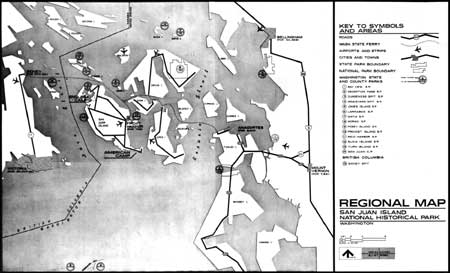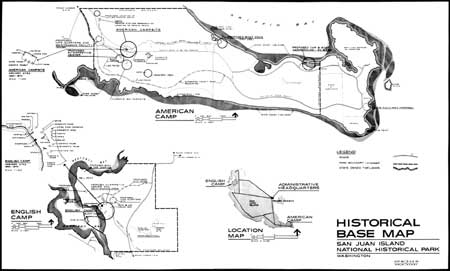|
SAN JUAN ISLAND
A Master Plan |

|
the region
ACCESS
San Juan Island can be reached only by water or air. The Washington State Ferry service from Anacortes, Washington to Sidney, British Columbia is the only automobile access to the island and takes two hours. Stops are made at Lopez, Shaw, and Orcas Islands before arriving at San Juan; an hour and forty minutes after leaving Friday Harbor the ferry arrives at Sidney, 17 miles from Victoria. Round-trip ferry fare from Anacortes to Friday Harbor for a family of five adults in a car is $17.40; round trip trailer fare is $10.20 for a 20-foot house trailer. Ferry capacity is 100 cars. During the summer there are 7 trips daily to and from Friday Harbor, except Friday and Sunday when there are 9. The winter schedule includes 2 trips daily with 3 on Friday and Sunday. There is an immigration officer at Friday Harbor, except Sundays and legal holidays and officials are at Roche Harbor and on the ferries during the summer.
Anacortes is approximately 80 highway miles north of Seattle and 35 miles south of Bellingham. Victoria, British Columbia is 92 miles by road around the north end of the Strait of Georgia; by ferry and highway it is 49 miles from Anacortes.
Another water access is by individual pleasure boats. The town of Friday Harbor has public docking facilities and Roche Harbor, on the north end of the island 2 miles north of English Camp, is a large boat harbor marina catering to private pleasure boats. It has all services for boats, a boatel, and restaurant. Other private docks are Jensen Boat Dock, Friday Harbor, and Snug Harbor near English Camp.
Air access is limited to small single and two-engined light aircraft. Three airstrips are surfaced for all-weather operation. The strip at Friday Harbor is a commercial facility and has lights for night use; a second strip at Roche Harbor is intended for those staying at the Roche Harbor development. A third strip has been constructed immediately north of False Bay for the Kings Lair development. Sea planes are able to land in the protected waters around the island.
At the Friday Harbor airport, the Island Sky Ferries Company provides the only scheduled commercial air access to the island. Scheduled flights operate between Bellingham and Seattle and Friday Harbor. Passenger fares are $5.50 from Bellingham and $12.00 from Seattle to Friday Harbor. Rental cars are available only at Friday Harbor, which also has a small facility for pontoon planes.
Circulation on San Juan Island is on county roads; there are no State or federally maintained roads on the island. Some 37 miles are categorized as arterial; these are paved with asphalt and are 18 to 20 feet wide. The 52.3 miles of collector roads that feed the arterials are not surfaced with asphalt but have a good gravel surface that affords all-weather use. Both English and American Camps are reached by gravel-surfaced roads.

|
| English Camp from end of wharf, approximately 1872. |
POPULATION
Anacortes, Washington. departure point for the State ferry to San Juan, is the largest town close to the site and had a population of 8,500 in 1960. Seattle, 78 miles south, has over 550,000 residents; Bellingham, 35 miles north, has 35,000. The State of Washington's population was more than 2,850,000 in 1960, an increase of 20 percent from 1950. The 1961 population of British Columbia was 1,629,000, an increase of 40 percent over 1951. The population of Victoria is 55,000.
Until 1950, the county population was increasing slowly at approximately 3 percent each year. That year, with 3,245 residents within the county, the limestone quarries on San Juan Island closed, forcing 470 workers to migrate. The current county population of 2,895 reflects a recovery and increase in the population trend. Summer residents on the island have increased from 334 in 1960 to 556 in 1965. By 1985 there will be an estimated 4,000 permanent and 32,000 summer residents in San Juan County.
PARK AND RECREATION FACILITIES
Olympic National Park is 40 air miles southwest of San Juan and Mount Rainier is 120 miles southeast. These are the only two National Park Service areas within this region. There are numerous national forests near Puget Sound, Olympic National Park, and north of Mount Rainier.
Adjacent State park development is quite extensive. Moran State Park, on Orcas Island in the San Juan group, has 4,800 acres and 180 campsites. The small San Juan County Park is about 4 miles south of English Camp at Smallpox Bay on the west side of the island. It has picnic tables and fireplaces, though paved roads or developed campsites have not been constructed. Within a 20-mile radius of Friday Harbor there are 35 campsites accessible only by boat and 560 campsites accessible by boat and car. Moran, Bayview, and Deception Pass State Parks are accessible by car, and Moran also by ferry.
Popularity of pleasure boating and fishing in the Puget Sound area is increasing rapidly; there were 56,000 registered pleasure boats in the area in 1965. Docking facilities for these boats will be in great demand in the future. Roche Harbor development, 2 miles north of English Camp, has public small-boat docking for a large number of boats, supplies, and boat services. The town of Friday Harbor has some public docking facilities. Miscellaneous docks on private lands throughout the islands are not for public use.
Fishing, especially for salmon, is extensive both for sport and commercially. There is some clamming on the beaches and mud flats; the cold water and limited amount of public beach discourage swimming.

|
| Blockhouse at English Camp looking southeast along the shore of Garrison Bay. The best preserved of historic structures on the island, it served the British during their 13-year occupation of San Juan Island. |
SURROUNDING AND EXISTING USE
In the Puget Sound, midway between Seattle, Washington and Victoria, British Columbia, are the San Juan Archipelegoes—172 widely scattered islands created by the exposed tops of ancient submerged mountains. They vary from lonely rocky knolls, submerged at high tide, to picturesque isles more than 50 square miles in size and rising 2,450 feet above the sea.
Typical of most mountain tops, the topography includes barren outcrop of bedrock, timbered slopes, and meadows which in recent years have been farmed. These islands are unique in their natural beauty and remain virtually unspoiled.
For many years, agriculture, dairying, logging, lime quarrying, and commercial fishing provided year-round employment. Today, the timber has been logged, farming and fishing have seriously declined, and the lime quarry has been closed for nearly two decades; all of which caused a shift in the economy of the island.
Recently, Washington residents, particularly the recreation enthusiasts near Seattle-Tacoma, and visitors from Oregon, California, and the nation discovered a new summer playground. The same natural beauty, solitude, and pleasant weather which attracted recreationists also encouraged retirement living. With them came a seasonal economy with its inherent problem of realizing enough revenue during the short season (60 to 90 days) to make seasonal services and accommodations feasible on a year-round basis.
This revived interest in the islands also prompted a very active real estate market; farms are being subdivided, waterfront and view property is being snapped up, and homes are being built. Irregardless of property price, many houses are mere driftwood and tar-paper week-end cabins, and are in sharp contrast to the many expensive retirement homes.
Friday Harbor, accessible only by air or sea, is the commercial center of the island and provides most day-to-day goods, services, and accommodations. Sports hunting and fishing opportunities are excellent on the island; however, charter fish trips are not generally available and hunting is discouraged except by 2 or 3 resorts that cater to this clientele.
The only commercial shipping of any significance is a sand and gravel company which ships to its parent company on Vancouver Island.

|
| Slope south from American Camp to Strait of Juan de Fuca. Slope in foreground and middle distance, including beach, is in American Camp area. |
ANALYSIS
The lack of easy access to the island limits the number of visitors to the park, though the State of Washington has indicated that larger and faster ferries will be added and there will be flexible schedules based on demands. The recreational use of the entire region has been expanding rapidly and continued growth is likely. The State and county populations will also affect the use of the park. The relative ruralism and remoteness of San Juan will soon be a thing of the past, and future generations will find their visit to San Juan Island made much easier.

|
| Regional Map. (click on image for an enlargement in a new window) |

|
| Historical Base Map. (click on image for an enlargement in a new window) |
| <<< Previous | <<< Contents>>> | Next >>> |
master_plan/sec1.htm
Last Updated: 07-May-2007